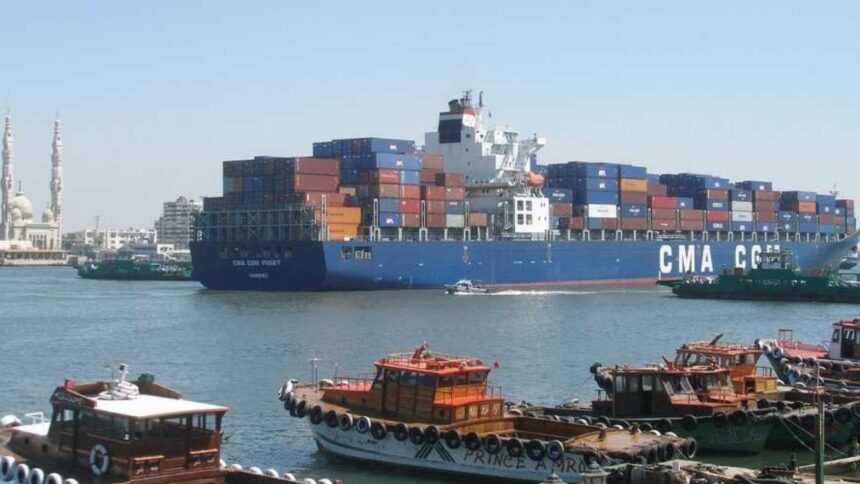Egypt’s Suez Canal Authority (SCA) is offering a 15 per cent discount from May 15 on transit fee to cargo ships of minimum 130,000 mt capacity, underscoring the impact that the Red Sea security crisis has had on the waterway critical to the shortest maritime route to the Mediterranean Sea and beyond from the Arab Peninsula, North-East Africa, and the Arabian Sea.
“The SCA has issued incentives and reductions of 15 per cent on the transit tolls of container ships of 130 thousand tonnes or more in net tonnage (loaded or in ballast) for 90 days,” said Admiral Ossama Rabiee, SCA chairman and MD after a meeting with the Italian Ambassador to Egypt, Michele Quaroni.
Earlier, Rabiee also reached out to 25 major shipping line operators and maritime agencies, urging them to gradually citing the positive development “towards the return of navigation in the Red Sea”. This came three days after US President announced that Iran-backed Houthi militia had agreed to a ceasefire in the Red Sea. The Houthis maintained that Israel-flagged and -linked ships are not part of the agreement with the US, and they will continue to be targeted .
In November 2023, Yemen-based Houthi rebels, backed by Iran, began targeting commercial vessels that they believed were linked to Israel and its key allies in response to its military offensive in Gaza. This crisis prompted the world’s major container lines to divert their ships from the Red Sea route and navigate around the Cape of Good Hope. With much of the cargo movement rerouting away from the Suez Canal, its revenue crashed to around $4 billion in 2024 from $10.3 billion in 2023.
“This (discount offered) seems to be a move to bring the container ships, also called boxships, back to the Suez Canal. Bulk carriers and tankships were diverted from the Suez Canal, but these boxships were a major source of revenue for the SCA,” said Anil Devli, CEO, Indian National Shipowners Association.
With the SCA offering steep discounts and the apparent calm in the Red Sea, even if fragile, the central question is: will vessels return to this key artery of global shipping and trade anytime soon?
The Suez Canal accounts for nearly 12-15 per cent of global trade, according to IMF data. Nearly 30 per cent of global container traffic flowed through the Suez Canal before the Houthi attacks began. It is also a key passage for 8-9 per cent of global energy flows.
As of May 11, 2025, Suez Canal’s daily transit trade volume (TTV) stood at 484,137 mt, compared with 1,349,086 mt a year ago, shows data from PortWatch, a live conflict tracker maintained by the IMF and Oxford University. TTV denotes the total volume of goods transported through a shipping route. Daily TTV stood at 11,052,600 mt as of May 11, 2025 at the Bab el-Mandeb Strait, compared with 1,192,116 mt a year ago, according to PortWatch data.
Daily TTV at the Cape of Good Hope moderated to 4,379,612 mt on May 11, 2025, from 5,761,366 mt a year ago.
According to an analysis by the Federal Reserve Bank of St Louis, ports in East Asia and the Pacific, Europe and Central Asia, the Middle East and North Africa witnessed a decline in the amount of trade between October 20, 2023 and January 28, 2024 compared to the year-ago period.
Shipping costs in the Suez Canal region soared 180 per cent during the period under consideration. “As firms reroute shipments, the companies that continue to ship through the Suez Canal are likely raising prices to compensate for the higher risk, as well as to take advantage of the reduced shipping supply,” the Federal Reserve of St Louis said.
Like various other countries, India was also heavily reliant on the Red Sea shipping route for exports to Europe, with nearly 80 per cent of the volumes going through the Suez Canal. The shifting of trade flows from the Red Sea to the route around Africa have evidently impacted Indian exporters by denting their margins as they now have to contend with higher freight rates for exports to Europe and beyond. With much of India’s trade dependent on overseas shippers and foreign-flagged commercial vessels, there is little the country can do in the short term to shield itself from the impact of the Red Sea crisis.
While the Red Sea security crisis hit traffic and revenue for the Suez Canal, it also led to higher shipping costs as vessels go around Africa, extending voyage durations—by 10-14 days—and fuel burn significantly, leading to higher freight rates. The longer voyages also made vessel availability tighter, again having an inflationary impact on freight rates. And for vessels still looking to transit the Red Sea, war risk insurance premiums skyrocketed, making the route unviable for most.
To be sure, while freight rates have risen as ships chose to go around the Cape of Good Hope, shipping companies have mostly passed on the cost to the consumers, Devli said. During this time, the SCA’s revenues crashed, while shipping lines were able to navigate the storm reasonably well, with global majors like Maersk reporting growth in revenue and profit on the back of higher freight rates and strong container demand.
“The Cape of Good Hope route has resulted in ship owners charging higher freight rates, as shown by the earnings of Danish shipping giant Maersk. The company’s vessels will continue to sail around the Cape of Good Hope since the declaration of a ceasefire was not adequate,” Devli added.
Given that the global shipping lines have adjusted rather well to the new normal of using the longer and safer route around Africa and still protecting—and even growing—their profits, there is little reason for them to return to the Suez Canal route till they are fully confident of the safety of their ships and crew.
“Even if the truce is a step in the right direction, I think many players will remain cautious until there’s consistent evidence that navigation is truly safe,” Arturo Regalado, Kpler Insight Senior LNG and Natural Gas Analyst said.
The Red Sea crisis has also hit liquefied natural gas (LNG) flows via Suez Canal which plummeted to 4.15 million tonnes in 2024 from 32.36 million tonnes in 2023 and 34.94 million tonnes in 2022 according to Kpler data. Meanwhile, LNG volumes going via the Cape of Good Hope increased by a little over five-fold from 11. 76 million tonnes in 2022 to 59.37 million tonnes in 2024.
According to industry watchers, a key factor that is adding to shipping lines’ hesitation is the fact that the Houthis are still likely to target Israel’s ships and those headed for Israeli ports, potentially making the maritime route volatile and unsafe for other vessels in the region when such attacks or counter-attacks are underway.








